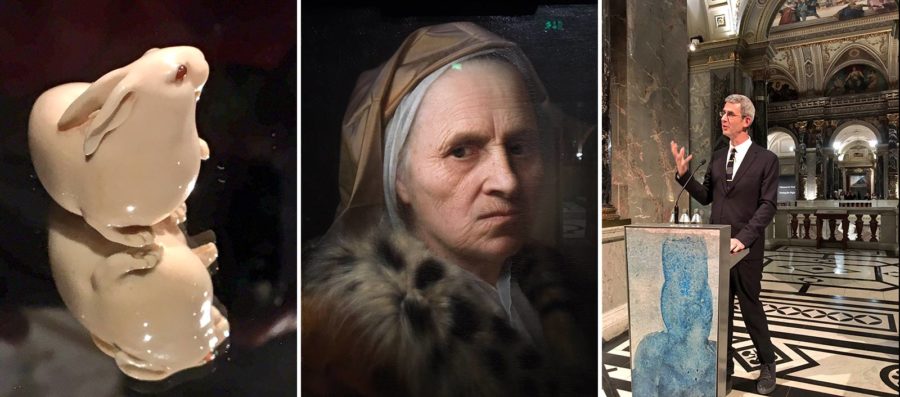It is 1.59 a.m. in Vienna. The city sleeps. But at the Kunsthistorisches Museum a crowd waits in eager anticipation.
At precisely 2 a.m., the British artist and writer Edmund de Waal steps forward to begin a talk called During the Night with the words “So, it’s two in the morning in the Kunsthistorische Museum. This might be a mistake.”
Edmund de Waal is known both for his ceramic works – usually white – and for writing, including his extraordinary and moving family memoir, The Hare with Amber Eyes, key – and tragic – elements of which are set in Vienna. In his work, he uses language as a metaphor for the formation of cylinders and pots, and pots as metaphors for forms of language: “As I make pots and write, there is a strong and stable relationship for me between objects and words and storytelling…..There is the space around objects and the space around words.”
De Waal was in Vienna on 26 November 2016 as curator of an exhibition called During the Night, which took as its starting point the 1525 depiction of a nightmare by Albrecht Duerer. De Waal chose works from the collection of the Kunsthistorisches Museum depicting dream, anxiety, dissonance and disquiet and produced as part of the exhibition one of his large-scale vitrines, in this case composed of black porcelain vessels and other materials. I blogged about During the Night in 2016.
The netsuke Hare with Amber Eyes, made famous by the eponymous 2010 memoir, was also on display, outside the entrance to, and deliberately not part of, the exhibition.
I was fortunate enough to meet Edmund de Waal, who is both charismatic and self-effacing. When I heard that he would be presenting a late-night talk on the topic of During the Night as part of a series of events at the museum lasting from 7 p.m. to 3 a.m., I knew I had to be there.
This Kunsthistorisches Museum website has a splendid video of de Waal introducing During the Night (first video) and, further down, de Waal’s own 2 a.m. talk – the title of which is splendidly translated into German as “Ein Late Night Event mit Edmund de Waal”.
I was able to discuss with Edmund de Waal whether he might be prepared to make a long-term loan of one of his works to the British Embassy in Vienna. I was conscious that in 2016, he had completed a work for the Ambassador’s residence in Beijing called A Short History Of The China Trade, a group of hand-thrown vessels in white porcelain arranged on white shelves in a glass vitrine. He was delighted to explore this idea; and with the aid of the Government Art Collection and Sir David Verey, we were able to install metamorphosen 1 at the residence in Vienna in 2017.
De Waal has made several series of black works, including metamorphosen 1, influenced by the time he spent in Vienna researching The Hare with Amber Eyes. These explore the relationship between dark glazed porcelain vessels and shards, next to different types of dark materials such as lead, Cor-Ten steel, graphite, oxidized silver and black marble. Cut as solid blocks, each acts as an interval in the ribbon of the installation – as de Waal describes: “…..placed as moments of pause or recollections of loss”.
The musical analogy of de Waal’s piece is important. metamorphosen 1 shares its title with a score for 23 strings composed by Richard Strauss during the closing months of the second world war. Often associated with the death of German culture, Strauss’s piece was in fact inspired by Goethe’s scientific text, On the Metamorphoses of Plants (1790) a positive exploration of rebirth and transformation.
It is a privilege to share the Residence in Vienna with such an important work of contemporary art. I am grateful to Edmund de Waal for making it available on long loan, and to Sir David Verey and the GAC for bringing it to Vienna. I look forward to bringing the work to the attention of visitors to the Embassy.

